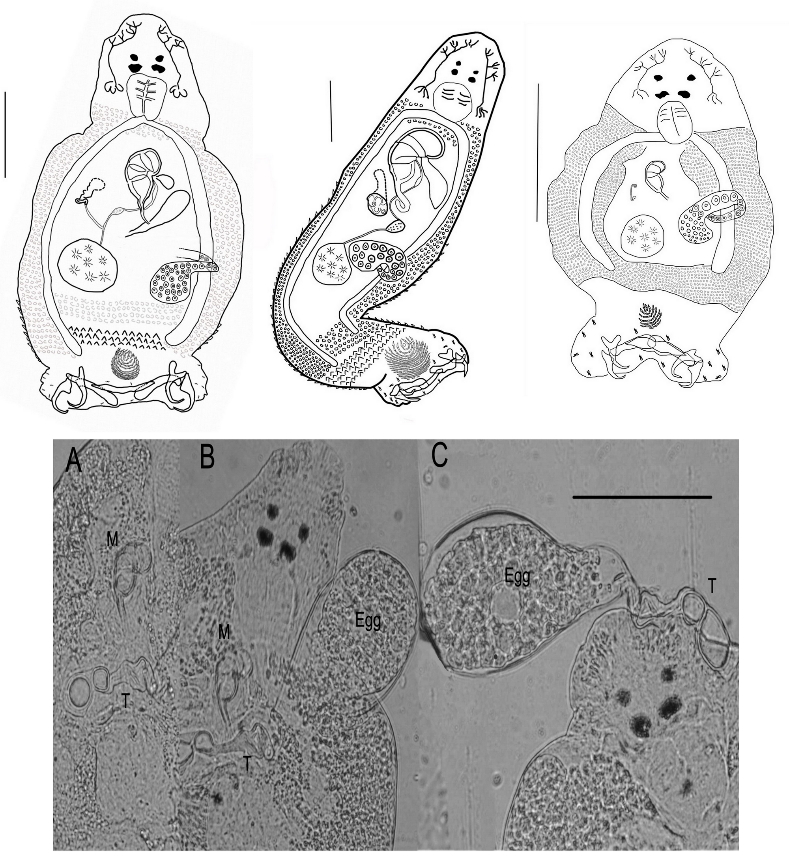 Three new species of monogenea are described from cultured and wild grouper from Nha Trang and Cam Ranh Bays, Vietnam. Pseudorhabdosynochus nhatrangensis n. sp and P. vietnamensis n. sp. were found on wild and cultured Epinephelus coioides and E. bleekeri, while Pseudorhabdosynochus brunei n. sp. parasitizes wild E. bruneus. P. nhatrangensis n. sp. is characterized by a sclerotized vagina with cup-shaped trumpet, open at the distal part, followed by a proximal tubular region, twisted to a circle at the posterior end and extending into thin branches; squamodiscs with 10 rows of rodlets with the central row being a closed circle. The tegument is scaly. P. vietnamensis n. sp. has a very large male copulatory organ with the tube being widened and slightly curved posteriorly. A sclerotized vagina comprised of an anterior trumpet, followed by convoluted structure which twists and divides into two distinct chambers. The central row of the squamodiscs forms a closed circle with a central core present. A heavily scaled tegument with scales on ventral and dorsal surfaces extends from the squamodiscs to the level of the ovary. P. nhatrangensiis n. sp. can be differentiated from other Pseudorhabdosynochus species by the vaginal structure. The complex vaginal structure and extremely large male copulatory organ of P. vietnamensis are similar to P. pai reported from E. tauvina, but these two can be distinguished by details of the vagina, and number of rows of squamodiscs (17–18 in P. vietnamensis and 10–11 in P. pai). P. brunei n. sp. possesses a sclerotized vagina with a tubular region and two serial chambers at the distal opening; squamodiscs have only 7 rows of rodlets. An egg of this species was found, being large and oval with a long sclerotized tail.
Three new species of monogenea are described from cultured and wild grouper from Nha Trang and Cam Ranh Bays, Vietnam. Pseudorhabdosynochus nhatrangensis n. sp and P. vietnamensis n. sp. were found on wild and cultured Epinephelus coioides and E. bleekeri, while Pseudorhabdosynochus brunei n. sp. parasitizes wild E. bruneus. P. nhatrangensis n. sp. is characterized by a sclerotized vagina with cup-shaped trumpet, open at the distal part, followed by a proximal tubular region, twisted to a circle at the posterior end and extending into thin branches; squamodiscs with 10 rows of rodlets with the central row being a closed circle. The tegument is scaly. P. vietnamensis n. sp. has a very large male copulatory organ with the tube being widened and slightly curved posteriorly. A sclerotized vagina comprised of an anterior trumpet, followed by convoluted structure which twists and divides into two distinct chambers. The central row of the squamodiscs forms a closed circle with a central core present. A heavily scaled tegument with scales on ventral and dorsal surfaces extends from the squamodiscs to the level of the ovary. P. nhatrangensiis n. sp. can be differentiated from other Pseudorhabdosynochus species by the vaginal structure. The complex vaginal structure and extremely large male copulatory organ of P. vietnamensis are similar to P. pai reported from E. tauvina, but these two can be distinguished by details of the vagina, and number of rows of squamodiscs (17–18 in P. vietnamensis and 10–11 in P. pai). P. brunei n. sp. possesses a sclerotized vagina with a tubular region and two serial chambers at the distal opening; squamodiscs have only 7 rows of rodlets. An egg of this species was found, being large and oval with a long sclerotized tail.
Three new species of Pseudorhabdosynochus (Monogenea: Diplectanidae) from Vietnamese grouper (Epinephelus spp.) (Perciformes: Serranidae)
Related
- Phylogeny of zoonotic parasites in fresh and brackish water fish in Vietnam (21-7-2014 12:12:31)
- Isolation, identification of luminous Vibrio in diseased cultured common seahorse (Hippocampus kuda) (04-8-2014 02:03:24)
- Phylogenetic relationship of giant clams (Tridacna spp.) collected in the South and Central coast of Vietnam (04-8-2014 02:01:42)
- Feeding mode of cone snail (Conus spp.) and phylogenetic relationships (04-8-2014 01:59:46)
Others
- About us (17-7-2014 09:35:40)
- SVM30022GR0249 "Management and restoration mangrove forests in the north of Khanh Hoa province - Toward sustainable landscape" (25-10-2023 09:44:51)
- VINIF.2022.DA00021 "DNA metabarcoding and integrated information database - Implication for Ichthyoplankton survey and fisheries management in Vietnam" (25-10-2023 09:53:54)
- Riverscape Genetics to Inform Natural History of Exploited Fishes in the Lower Mekong River Basin (23-10-2017 11:43:14)
